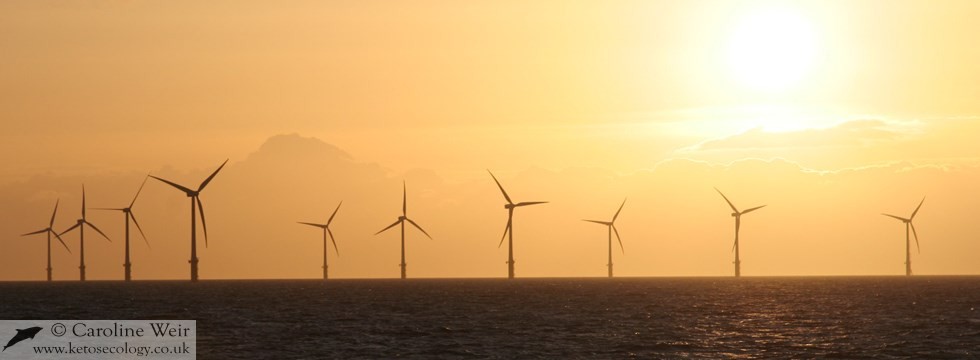Seismic surveys, pile-driving and sonar: human sound and cetaceans
Anthropogenic impacts on marine mammals potentially include direct mortality (e.g. whaling), injury (e.g. hearing loss), disturbance, displacement from key habitat, stress, and disease arising from a range of human activities including fishing, pollution, coastal development, military activity, offshore marine renewables and offshore industry.
Caroline Weir has been involved for many years in the mitigation of potential anthropogenic impacts from offshore renewables and industry on marine mammals, in a consultancy role (producing marine mammal mitigation protocols and environmental impact assessments), during survey work (implementing real-time mitigation measures during industrial activities) and in a research capacity. This has resulted in the publication of peer-reviewed papers on existing marine mammal mitigation guidelines worldwide and recommendations for their future development, in relation to seismic surveys, military sonar surveys and offshore renewable developments (focussing on pile-driving). Additionally, significant amounts of response data on marine mammals have been collected during seismic surveys off Angola, and analysed in relation to determining whether impacts are occurring in response to sound sources.
Some other avenues for minimising the potential impacts of industry on vulnerable and endangered marine fauna have been developed and advocated in recent years. The promotion of the use of ‘turtle guards’ to minimise the accidental fatal entrapment of sea turtles in certain models of tail buoy used by the seismic industry is an ongoing work, and a download containing information on this issue is available (download here). Similarly, an advisory document was developed with regards to promoting voluntary efforts to release live sea turtles that are observed entangled in discarded fishing gear by MMOs and vessel crews while operating in tropical areas (download here)

Oil rig in the sunset.

Seismic survey vessel.
Selected publications from anthropogenic impact research:
Dolman, S.J., Green, M., Gregerson, S. and Weir, C.R. (2016). Fulfilling EU laws to ensure marine mammal protection during marine renewable construction renewable construction in Scotland. Advances in Experimental Medicine and Biology, 875: 223–230.
Nelms, S.E., Piniak, W.E.D., Weir, C.R. and Godley, B.J. (2016). Seismic surveys and marine turtles: an underestimated global threat? Biological Conservation, 193: 49–65.
Nelms, S.E., Godley, B.J., Weir, C.R. and Piniak, W.E.D. (2015). Assessing the potential impacts of seismic surveys on marine turtles. Presentation at the 35th Annual International Sea Turtle Symposium, Dalaman, Muğla, Turkey. 18–24 April 2015.
Dolman, S.J., Green, M., Gregerson, S. and Weir, C.R. (2013). Fulfilling EU laws to ensure marine mammal protection during marine renewable construction renewable construction in Scotland. 3rd International Conference on The Effects of Noise on Aquatic Life, Budapest, Hungary, August 2013.
Dolman, S.J., Weir, C.R. and Jasny, M. (2009). Comparative review of marine mammal guidance implemented during naval exercises. Marine Pollution Bulletin, 58: 465–477.
Weir, C.R. (2008). Overt responses of humpback whales (Megaptera novaeangliae), sperm whales (Physeter macrocephalus), and Atlantic spotted dolphins (Stenella frontalis) to seismic exploration off Angola. Aquatic Mammals, 34: 71–83.
Weir, C.R. (2008). Short–finned pilot whales (Globicephala macrorhynchus) respond to an airgun ramp–up procedure off Gabon. Aquatic Mammals, 34: 349–354.
Weir, C.R. and Dolman, S.J. (2007). Comparative review of the regional marine mammal mitigation guidelines implemented during industrial seismic surveys, and guidance towards a worldwide standard. Journal of International Wildlife Law and Policy, 10: 1–27.
Weir, C.R. (2007). Observations of marine turtles in relation to seismic airgun sound off Angola. Marine Turtle Newsletter, 116: 17–20.
All content and images are copyright Caroline R. Weir (2025)


